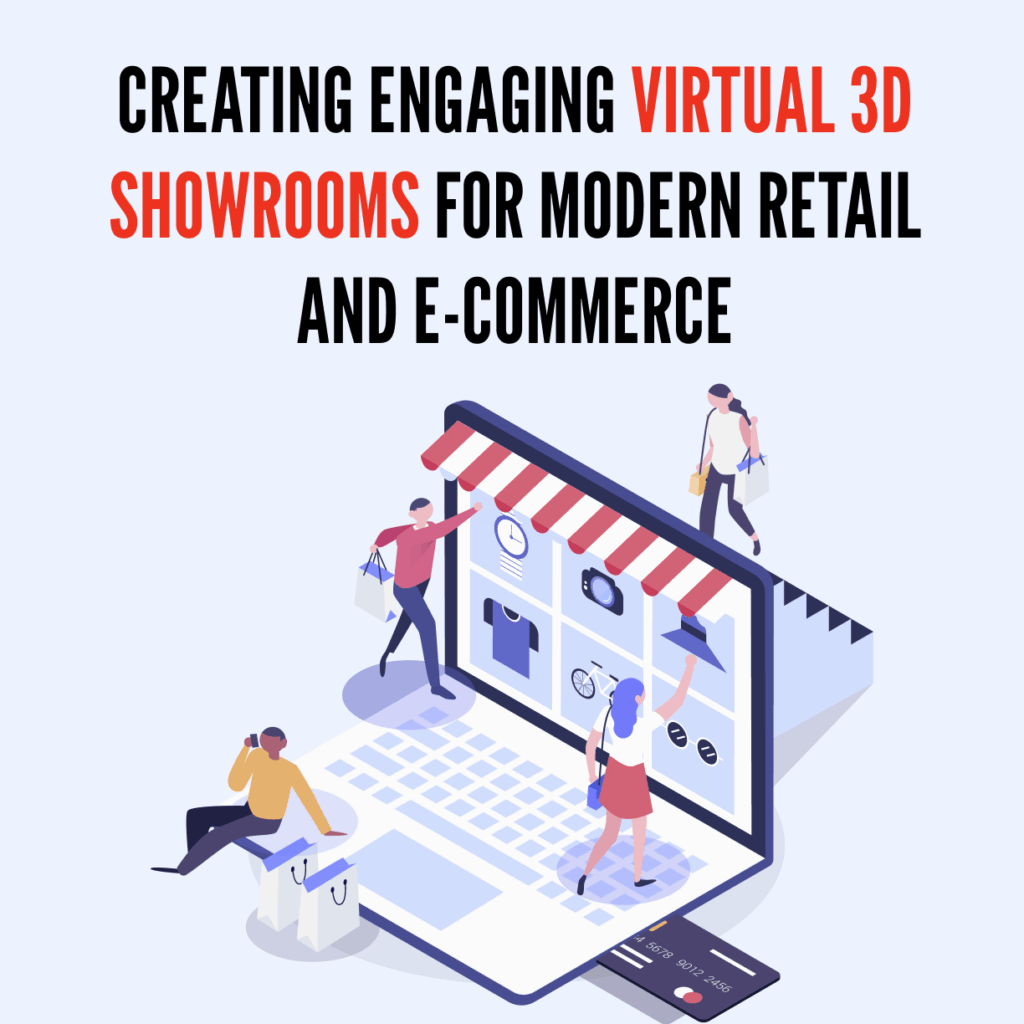|
Getting your Trinity Audio player ready...
|
Retail is no longer the same; it has really gone online, and therefore shopping is less able to offer radical or innovative things from just a webpage of products. Brands now compete on providing experiences that really are immersive and unforgettable in a digital experience and hence Virtual 3D Showrooms enter the scene and are changing the way retail and e-commerce interact with customers. The new-age world of digital stores roams through lifelike 3D products viewed and handled much as if they were there.
Adopted from furniture, fashion, cars to luxuries, and businesses, they embrace 3D product visualization and interactive virtual showrooms to create a link between online and offline shopping. This is the fusion of AR, VR, and AI-powered virtual showroom technology. It not only raises customer engagement, but it is also redefining customers’ expectations and their purchasing behavior.
Virtual showrooms are digital effectiveness and sales instruments for e-commerce: increased confidence, diminished returns, and prolonged contact. It is much more than mere beauty; being dramatic, it is also a mighty means for narrative, personalization of recommendations, and gathering rich behavioral data for future strategy.
Built as the top digital transformation and 3D development company, Esferasoft has engineered businesses towards creating engaging, high-performance virtual 3D showrooms, merging innovation with interactivity and measurable impact. Such environments are no mere visual upgrades. They are also the next steps of human-centered retail, where with every click, the experience feels just like a real-world encounter.
What is a Virtual 3D Showroom?
A virtual 3D showroom refers to an interactive digital environment that helps replicate the physical experience of walking into a retail store, feeling it through the touch of the mouse. There are a lot of 3D rendered environments for users to surf the internet in. Here, they can observe from multiple angles, pick items up in real time, and inspect them closely. All of this is done using technologies such as 3D modeling, WebGL, AR/VR, and AI; these work to create completely new dimensions of interaction and perception for customers on anything they may want to evaluate in the digital world.
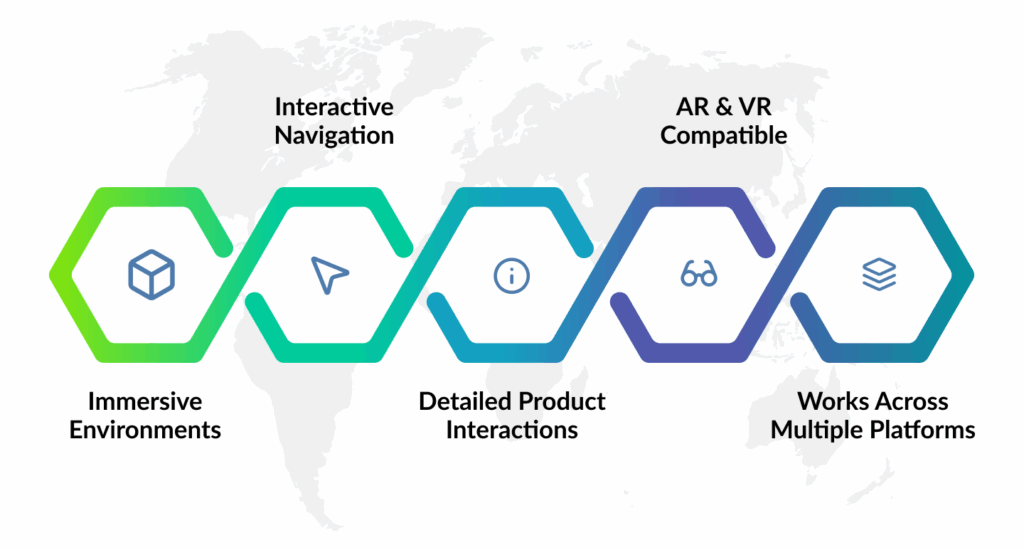
Definition and Major Characteristics
In essence, a virtual 3D showroom operates as a digitally rendered store available to customers via web browsers, mobile apps, or VR headsets. It blends 3D product visualization with real-time lighting and interaction models to bring immersion to the browsing experience.
Some major characteristics include:
- Immersive Environments: Lifelike 3D spaces that resonate with the brand look and store layout.
- Interactive Navigation: Users can “walk,” zoom, or rotate products simply with gestures or mouse controls.
- Detailed Product Interactions: Hovering over items reveals specifications, color variants, or pricing.
- AR & VR Compatible: Letting customers visualize how a product fits into their space or lifestyle.
- Works Across Multiple Platforms: Provides a unified experience within web, mobile, and VR ecosystems.
Such a digital setting tries to marry the sensory feel of a physical retail experience with e-commerce convenience, giving way to an interactive or narrative experience that neither images nor videos can replicate.
How Does It Differ From More Traditional Online Stores?
The traditional e-commerce sites describe product listings in flat terms with static images. Efficient as they are, such presentations often inhibit scale, texture, and real-world context. In contrast, a virtual showroom provides 3D, lifelike, and sensory immersion for its customers to get their hands virtually on or inspect products before actually buying.
Where the online stores showcase, the virtual showrooms allow users to experience.
Whereas standard sites depend upon clicks, 3D environments induce emotional engagement.
This interactivity serves to increase the time spent by customers, enhance brand recall, and instill confidence in purchase decisions. With this, customers are presented with an engaging and persuasive online shopping experience that feels highly personalized and very real.
Do you want to upgrade your online store with an immersive 3D showroom?
Esferasoft experts design custom AI-integrated virtual showroom solutions for your brand’s products and audience.
Virtual 3D Showrooms Have Advantages
A virtual 3D showroom is an innovative visual tool that is a strategic business asset. It integrates the immersion of physical retail with the accessibility of online shopping and thus restructures the way brands attract, engage, and convert customers. Enhanced engagement and global accessibility—its effects continued to impact every layer of the customer journey.
Enlarged Customer Engagement
Static product pages do not often have the ability to retain attention for more than a few seconds. But virtual 3D environments can take visitors into an interactive environment where they can walk through spaces, inspect items from every angle and personalize features in real time. This sense of control and exploration actively participates in passive browsing.
As a result, longer sessions, more emotional attachments, and more engaging shopping experiences are expected to create return visits. For lifestyle and luxury brands, it constitutes a digital storytelling platform, one that transmits the craftsmanship and design, as well as the exclusivity, through experience rather than using just words.
Sales Increased and Conversion Rates
Whether for viewing the interior of an automobile, jewelry, or even a sofa within its context, a customer’s ability to fully envision a product means that he or she can make a quicker and far more confident buying decision. According to what research shows, interactive 3D visualization can increase conversion rates up to 40% compared to static e-commerce listings.
Brands create a personalized funnel during every interaction streak. With real-time configuration, AR try-on features, and AI recommendations, customers may now take fewer steps to move from interest to purchase.
Less Need for Physical Space
For retailers, showrooming has always involved huge areas, logistics, and maintenance costs. The entire overhead is made redundant by digitizing it into a scalable virtual space. Thousands of SKUs can be showcased without keeping them in actual inventory, reducing operational costs and speeding up product updates.
The new marketplace, which caters well to entry- and niche-markets, opens to global brands or new vendors willing to launch collections or experiment with new designs without investing heavily in traditional physical retail space.
Around-the-clock and Global Reach
This virtual 3D showroom never closes. Manifold time zones give customers an opportunity to search, compare, and buy in their spare time—consequently giving the retailer a market far beyond its geographical constraints. This is purely a borderless retail ecosystem, with multilingual interfaces and device compatibility.
Improved sales potential, along with this reach beyond physical borders, also positions brands as innovative and customer-centered leaders in their field.
Analytics and Insights into Customer Behavior
Every movement a user makes in a 3D environment becomes trackable and analyzable. Heatmaps, dwell-time metrics, interaction data regarding products, and so on, would furnish businesses with customer-intent insights. All design improvements, marketing strategies, and inventory decisions become clearer as every visitor’s experience becomes progressively smarter over time.
When someone engages from such a virtual showroom, it is transformed into intelligence. Brands evolve dynamically with the consumer behavior trend.
Change the way your customers buy.
Esferasoft builds 3D interactive showroom experiences that increase engagement and improve conversions and business results.
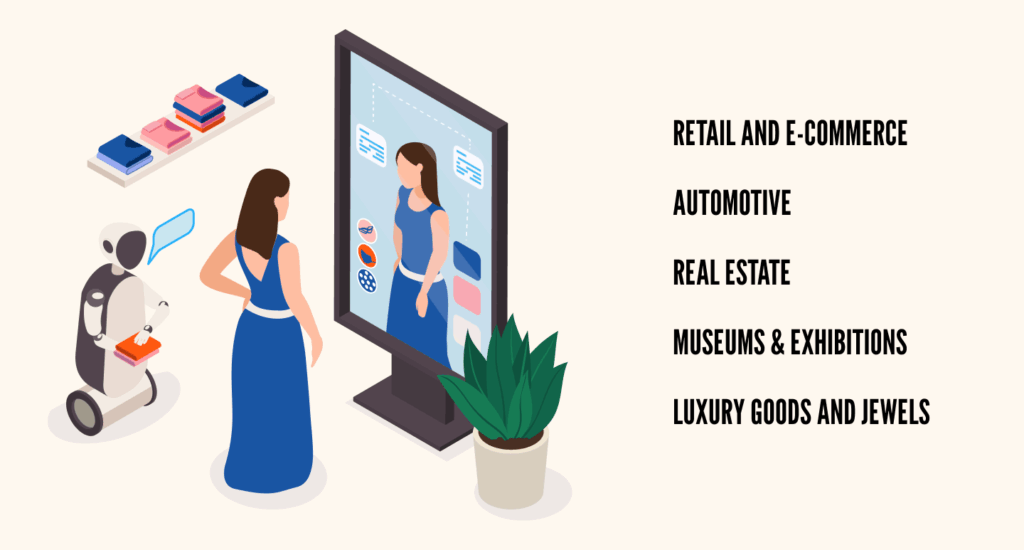
Industries Leveraging Virtual 3D Showrooms
Virtual 3D showrooms are no longer confined to the retail industry; rather, they revolutionize the means through which brands present, sell, and connect with customers in every industry. When combined with true realism and interactivity, these showrooms create immersive experiences that bridge the gap between the physical and digital worlds.
Retail and E-commerce
Building such virtual showrooms calls for bringing life as closely as possible to an online shopping experience for fashion, furniture, and electronics brands, really allowing a shopper to move, view the products from all possible angles, and visualize items within a real place. It builds confidence, minimizes returns, and allows users to be engaged.
Automotive
3D product visualization means that vehicle manufacturers now have the option to provide the option of virtual test drives with interactive configurators, where the consumer sees what is on the inside, experiments with a few color options, and understands every single detail in the design—all without even stepping into a dealership. It is immersive, cost-efficient, and rich in data.
Real Estate
Virtual walk-through for the developers and agents to showcase properties under construction or far away from the eyes of potential buyers. The optimum situation for the buyer to navigate spaces and change the layouts leads to much quicker informed decisions—converting interests earlier than sales are completed.
Museums & Exhibitions
Interactive digital spaces virtualize cultural institutions for a world audience so that visitors can wander around galleries, view artifacts in 3D, and access multimedia content from wherever they are, extending engagement above and beyond the physical limits.
Luxury Goods and Jewels
Digital exclusivity for luxury brands gets another twist with high-fidelity virtual showrooms. Consumers can zoom in on diamond cuts, AR try-on jewelry, and see it under perfect lighting conditions, replicating that luxury feel of in-store browsing online.
Bring your industry closer to its audience with immersive 3D experiences.
Esferasoft designs a custom-tailored virtual showroom solution to convert browsing into buying.
How Virtual 3-D Showrooms Are Made
There lies a magic blend in designing a virtual 3D showroom that would deliver the seamless experience through precise design, interactive techniques, and performance engineering. At Esferasoft, each project follows a stringent procedure fusing creative vision with technical execution, ensuring that the showroom not only looks fantastic and performs well but is also aligned with the business goals.
3-D Modeling and Texturing
This is the very first process of creating products in 3D that designers created these elements with high accuracy by replicating closely similar items to the original. Using these tools like Blender, Maya, or 3dsMax, textures, materials, and lights are added to allow the products to appear real. Every surface from fabric to metal is designed to react and move naturally with light and movement. It thus enables the customers to be exposed more closely to the true sense of realism.
Interactive Features (360° Views, Zoom, AR Integration)
The defining element of a successful virtual showroom is interactivity: it offers customers rotating, zooming, or exploring their products from any angle, making 360° products views, AR previews, and virtual try-ons more engaging. Motion triggers, hover effects and click-able hotspots make every interaction very intuitive and informative.
Platform Development (Web, Mobile, VR Headsets)
Now that everything is ready, developers build the digital showroom platform. They can do it using WebGL, Three.js, or game engines such as Unity and Unreal. Such development approaches would result in a cross-platform experience, allowing customers to browse showrooms via web browsers or mobile devices as well as through virtual reality headsets.
Integration with E-Commerce & Payment Systems
When combined with e-commerce applications, the 3D showroom comes to life. It allows Esferasoft to link shopping carts, CRM instruments, and secure gateways for payments into an integrated process that will stretch seamlessly from product discovery to purchase. Customers will be able to purchase right inside the showroom. No browser redirects, no friction.
Testing and Performance Optimization
Testing comes at last for performance perfection. Esferasoft is engaged in load testing, browser tests, and rendering optimizations. The test was deployed to ensure speed and quality across all devices. Light assets, texture compression, and the principle of real-time rendering ensure uninterrupted interaction without compromising on visual fidelity.
Technology Stack for Virtual 3D Showrooms
From conception to implementation, a virtual 3D showroom requires much creative and technological knowledge. Each individual element—from the 3D modeling software to the AI engine—is integrated to paint an immersive experience with delightful satisfaction across domains.
3D Modeling Software-link Blender, Maya, 3ds Max
Realistic product modeling creates the bulk for any 3D showroom. Blender, Autodesk Maya, and 3ds Max are used to produce 3D assets of superior quality with good textures, lighting, and animation. These assets present the physical product in a digital space, allowing the user to treat the objects/surroundings as though they were real.
Game Engines & Real-Time Rendering-unity & Unreal Engine
Once again, these game-dev engines have come into play for creating interactive 3D assets. Users can get hold of real-time rendering, fluid motion, and user-responsive navigation on these platforms. Along with that, they have VR and AR compatibility, which allows the user to convert a still environment into a fully responsive immersive space.
Web Technologies—WebGL, Three.js
The web experience developed by Esferasoft via the use of WebGL and Three.js offers lightweight but very powerful 3D environments. These technologies make sure users access the showroom from within a web browser and that too, without requiring any specialized plug-ins or downloads, so it is smooth, scalable, and device-friendly.
AI & AR Integration for Enhanced Interactivity
Augmented reality and artificial intelligence bring another layer of user experience. In understanding the diversified purpose of AI-enabled personalization in product recommendations based on user behavior and augmented reality visualization on a customer’s mobile phone regarding product previews in his or her own freaking environment, we have much more responsive, intelligent, and interactive digital showrooms.
Esferasoft incorporates these technologies to develop digital showrooms that muster not only visual appeal but also strong operational capabilities across web platforms, mobile, and immersive. Thus, transforming into a futuristic virtual experience that converts and delights.
Features That Make Your Virtual 3D Showroom More Appealing with AI
Artificial Intelligence is revolutionizing the operation and transformation of the virtual 3D showroom. From built-in automation, personalization, and predictive insight, AI further allows brands to present immersive experiences that are intelligent, adaptive, and data driven.
Personalization in Product Recommendations
Real-time recommendations of different products by an AI that analyzes each visitor’s browsing pattern and past purchase and interaction behavior. Within a 3D showroom, those recommendations surface naturally—like showing complementary accessories while viewing a product or showing alternative styles in proximity. The end product is a more intuitive, guided shopping experience that amplifies satisfaction while driving conversion.
Chatbots & Virtual Sales Assistants
AI-integrated chatbots or virtual sales agents play the role of digital mirrors of in-store associates—convincing customers with their inquiries, recommending items, and transacting without stepping out of the showroom. It is even able to read mood and tone in a regex-driven manner, providing support for the user through a conversational style very much in touch with humankind, at least as immediately as possible.
Customer Behavior Predictive Analytics
Every action is captured by AI, and behavior is interpreted to infer intent and trend prediction. Heatmaps, durations of views, navigation paths, etc., will reveal those actionable insights that tell businesses which products attract attention and which lead to sales. This insight enables a more evidence-based approach toward the layout, pricing, and marketing strategies of your showrooms.
Automated Content Generation & Scene Optimization
Automated tasks, such as generating variants of products, texture optimizing, or simulating lighting for realism, would have previously taken hours. Of its most notable abilities in level of capability, AI could develop wholly new three-dimensional assets through generative models, thereby cutting production expenses and saving time on launch. Real-time performance has ensured that visuals stay high quality without affecting the experience.
Proponents of AI virtual showroom know-how go beyond displays—they learn, adapt, and evolve from each site visitor. It amounts to a smarter digital environment that keeps the customer entrapped and the businesses ahead in predicting changes in consumer behavior.
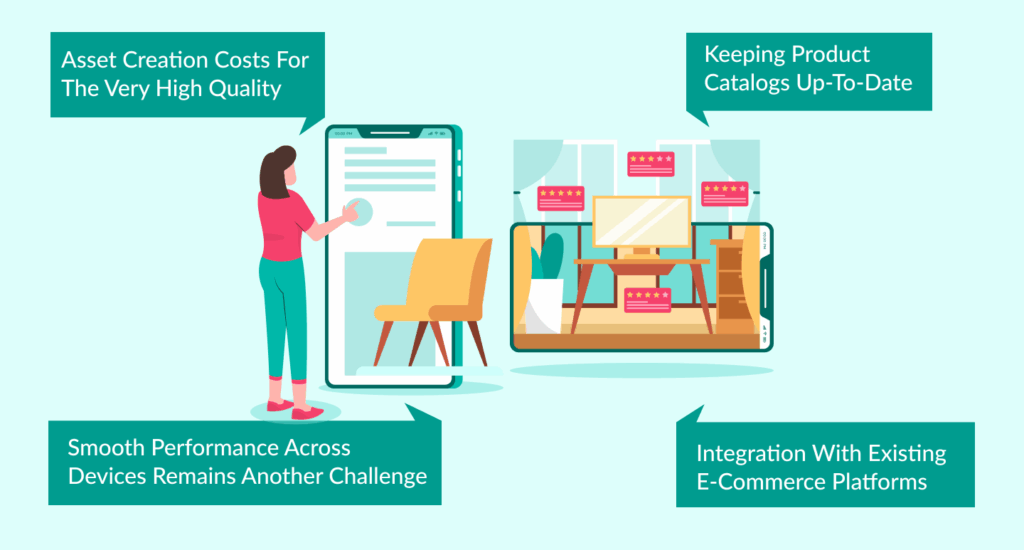
Difficulties in Setting Up the Virtual 3D Showrooms
Though 3D virtual showrooms offer unparalleled potential in conversion and engagement, putting them together poses situations of technical and operational challenges. The insight into these enables businesses to strategize well to attain smoother implementations.
Asset Creation Costs for the Very High Quality
Realistic 3D assets are the keystones of an effective virtual showroom. On the flip side, the making of such would necessarily involve skilled designers, powerful software, and indeed high-performance rendering. Models must be optimized for web and mobile devices and they should not lose their detailing. This procedure could stretch for some time and maybe at times. It could be even time-sensitive, especially for brands that cater to a large number of products in their catalogs.
Smooth Performance Across Devices Remains Another Challenge
Another challenge would be to maintain performance standards across different platforms for desktops, mobiles, and VR. Heavy on visuals, a showroom must still be light enough to allow quick loading for different devices and over varied network conditions. Quality vs. Performance entails continuous testing, compression, and optimizations for different screen resolution balances.
Keeping Product Catalogs Up-to-Date
Virtual showrooms thrive on dynamic content, and the updating process can be complex. If a virtual showroom does not reflect the changes made to the inventory, pricing, or design in the 3D environment instantly, it loses its charm. An automated system linking the e-commerce platforms with the 3D databases is therefore very important to keep everything in sync without having to manually update anything.
Integration with Existing E-Commerce Platforms
Application interfaces are critical in this case since backend integration will help in the smooth merging of 3D showrooms with already realized e-stores, CRMs, and payment gateways. Planning without careful consideration could disrupt existing workflows or create technical bottlenecks. Hence, selection of a development partner with expertise on both fronts—more creative and technically capable would ensure that integration is entirely seamless and scalable.
Though quite challenging, the long-term benefits—index of engagement, accessibility from anywhere in the world, and measurable business growth—definitely outweigh the trouble. With better planning, tools, and partners, all these obstacles could be resolved, thus resulting in an immersive experience that paves the way for the future of digital commerce.
Best Practices for Running an Effective Virtual 3D Showroom
Creating a fabulous-looking virtual 3D showroom is just one part of enabling brands to make it really useful. It must now focus on usability, performance, and further refinements. The most successful digital showrooms combine realism with user-friendly navigation and performance trickery so all visitors, on their busy schedules, can feel the journey was easy and fun.
Web and Mobile Performance Optimization
The 3D showroom should look excellent but should remain light enough. Smaller assets hold their own, together with adaptive rendering and streaming based on WebGL or the cloud, which makes loading times faster on any device. Performance optimization does keep the user engaged, thereby reducing the bounce rate, and is even more critical on the mobile side.
Prioritize Intuitive Navigation and UX
It should feel like exploring, not like learning how to operate. A clean UI, guided hotspots, and responsive controls will keep things easy to navigate. Such an interface would incorporate the minimal learning curve, thus allowing the user to focus on the product rather than the mechanics.
Creating Realistic Textures and Lighting
Visuals drive the trust factor. With PBR methods, realistic materials, and lighting simulation, the product appears far more lifelike. If a customer can feel a material, like fabric texture or metal gloss, the purchase is less steeped in uncertainty.
Add Analytics for Continuous Improvement
Optimization is about data. Tracking for user movement, dwell time, and product interaction will help the brand adjust the showroom layout, emphasize bestsellers, and customize the experience over a period of time. AI-powered analytics dashboards can then provide insights into driving the presence and friction of both engagement and sales on a continuous basis.
Seamless convergence of performance, high design standards, and data in such an ecosystem would create instant sale converters. Following such principles, Esferasoft develops these virtual experiences aimed at enticing visitors and converting them into lifelong clients.
Cost and Time Considerations
Building a 3D virtual showroom involves working on multiple fronts which include 3D assets creation and e-commerce integration. The cost and time can vary widely with the proximity of many factors, including the project complexity, features, and technology choices. With all the variables well understood, any business will be able to properly plan its investment.
Factors Affecting Price
1. Complexity of 3D Assets
High-detail product models, specialized textures, and advanced lighting setups take more time to design and require additional processing power. Simple, catalog-style displays are made quickly, adding enhanced interactivity through photorealistic environments, which rapidly increases costs.
2. Platform and Feature Set
Generally, web-based showrooms are cheaper to create than fully immersive VR environments. Advanced functionalities such as AR previews, AI recommendations, or voice navigation all come with extra pricing impacts but hugely bring value for the user experience and conversions.
3. AI and AR Integration
Smart automation, predictive analyses, and AR compatibility build an extra layer of development. The outlays at the initial stage will be high, but these functionalities will bring long-term value through engagement and retention.
Typical Development Timeline
Thus, in general, a very basic 3D showroom with standard navigation and a reduced product catalog can be developed within 4-6 weeks. A full-fledged interactive showroom with AI personalization, e-commerce integration, and VR usually takes 10 to 14 weeks for a fully extensive and thorough process, including testing and optimization.
The agile workflow from Esferasoft helps in flexible scaling, allowing the clients to create a minimally viable version for launch and thereafter develop the solution based on user feedback and business growth.
In-House versus Outsourcing
Developing a virtual showroom in-house would require staff with easy access to 3D artists, developers, and cloud infrastructure—not resources readily available to every business. Esferasoft is fast-tracked by an outsourced specialized developing company that offers professionally created assets that will be technically supported over the long haul. Esferasoft ensures that your projects meet the benchmarks on design and performance.
The investment in a 3D showroom is now an ROI proven against higher engagement, lesser returns, and global reach for the brand, all partnered with the right partner.
Confidently plan your 3D showroom.
With Esferasoft, guaranteed predictable pricing and timeliness, as well as custom solutions for businesses of any size.
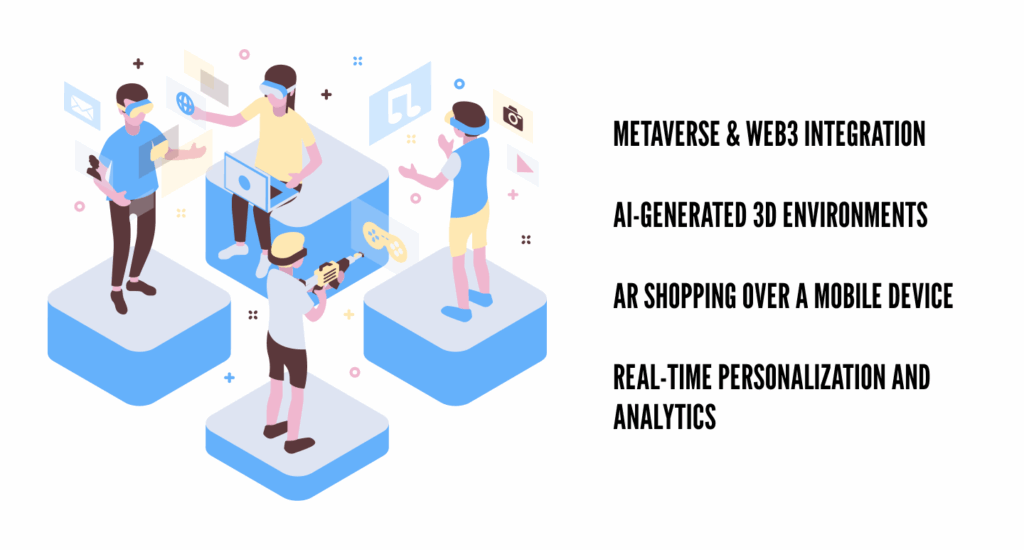
Future Trends of Virtual 3D Showrooms
As technology progresses, 3-dimensional virtual showrooms become the core of the retail and digital commerce future. This next generation of such platforms will combine realism with intelligence and interactivity, transforming how customers shop and how brands will operate on an online basis.
Metaverse & Web3 Integration
Emerging metaverse and decentralized platforms promise to offer an ever-present, common space in which all can interact with one another. Soon, brands will enable the individuals to visit their interactive showrooms posted in Web3-managed environments, where one can browse, shop, and even take ownership of creations associated with physical offerings via NFTs.
AI-Generated 3D Environments
Generative AI, in many aspects, is going to simplify the process of creating applications of 3D assets and different environments. With the potential generation of quality textures, lighting, and animations through seconds of AI tools, businesses can grow their catalogs and turn around virtual showrooms in record time. This automation will significantly cut design time and costs.
AR Shopping over a Mobile Device
Mobile-first AR experiences will be the new normal for consumers. Shopping becomes much more meaningful as shoppers can see how the products will be in real life: fitting with jewelry or previewing it within their rooms, and more importantly, viewing cars in total size. The marrying of 3D visualization with AR convenience will bring about speedier decisions to buy.
Real-time Personalization and Analytics
A showroom of the future is one that changes in every moment—layouts will change, some objects will be featured, or an offer will change. Enabling such change are the integrated AI analytics systems that will measure emotional engagement, attention patterns, and purchase likelihood to convert every meeting into valuable data.
The future of virtual showroom e-commerce would be an intelligent, networked ecosystem where real shopping feels the same as a person’s interaction.
Conclusion – Redefining Customer Experience Using Virtual 3D Showrooms
Evolution of virtual 3D showrooms represents a point in the time continuum where brands interface with modern consumers. The inception of offering a visual enhancement to online shopping has matured into a bridge that connects digital ease with physical experience. 3D visualization, artificial intelligence, and immersive experience together allow for the creation of checkout experiences much more engaging than just static product pages—a promise of a personalized journey built on an engaging story that establishes trust and drives sales.
Online shopping is being redefined across the retail, real estate, and luxury sectors; these showrooms invite an assortment of measurable results—enhanced engagement, better conversion, and a truly international reach.
At Esferasoft, we partner with companies that are serious about transforming their digital customer footprint through interactive AI-powered virtual showrooms that cater to current customers and tomorrow’s market.
E-commerce is becoming yesterday’s news, and experiential retail is here to stay!
Join us in making your next-generation virtual showroom that inspires, interacts, and converts. Call us now at +91 772-3000-038!
FAQ’s
1. What is a virtual showroom in 3D?
Virtual 3D showrooms are mainly interactive digital spaces for customers to explore, view, and interact with products in a lifelike 3D environment. This form of shopping experience replicates what a physical store looks like but is accessible online; thus, it offers more immersive shopping experiences through features like 360° views, AR visualization, and real-time interactions.
2. In what way does a virtual showroom transform and ramp up customer engagement?
Really transform passive browsing into active exploration, so the user is now able to roam freely, zoom in on details, and visualize products in real-world settings and, from all those features, get high dwell times, emotional connection to products, and purchase security—all factors that would trigger engagement and lead to loyalty boosts.
3. What technologies are behind the virtual 3D showrooms?
Virtual 3D showrooms are based on a combination of mostly 3D modeling software (Blender, Maya, 3ds Max), game engines (Unity, Unreal Engine), and web technologies like WebGL and Three.js. There are even more advanced integrations, including AI personalization, augmented reality previews, and real-time rendering, making them all the more interactive and efficient across devices.
4. Can virtual showrooms be accessed on mobile devices?
Most certainly. Very few virtual 3D showrooms are not mobile browser and mobile application friendly at the moment. Using responsive design and WebGL rendering, customers can have an uninterrupted and seamless experience when exploring products on a smartphone and tablet.
5. In what aspects do virtual showrooms save costs when contrasted to physical stores?
A digital showroom will not require funds for physical space or for maintaining inventory displays. Brands can now showcase thousands of products online, including instant catalog updates that reach global audiences without incurring traditional overhead for retail setups.
6. Are sales likely to increase and returns diminish in virtual showrooms?
It is indeed. Augmented visualization and AR try-ons provide customers a realistic idea about the product they are purchasing. The more outright confidence is developed within the buyer through these processes, the less the probability that a buyer will make a return; hence, there is increased sales conversion with informed buyer decisions.
7. In which industries does the 3D virtual showroom apply?
Among the many sectors benefiting from the adoption of virtual showrooms, top of the list include retail, automotive, real estate, luxury goods, and furniture. These virtual showrooms mainly direct customers towards adopting looking at products or spaces in an engaging way and accelerating their purchases.
8. How can AI improve the virtual showroom experience?
AI makes that personal connection and provides both automation and intelligence to the process through which the system can make recommendations of products based on user behavior, allows virtual sales assistants to function, and poses predictions through analyzers. AI dynamically optimizes visuals and layouts to create smarter and adaptive environments that evolve in tune with user preferences.
9. What features must be there in a good virtual showroom?
Great virtual showrooms include the following:
- High-Quality 3D Visualizations and Lighting Effects
- Smoothness of Navigation and Interactivity
- AR/VR Capability
- AI-based Recommendations
- Tracking Analytics
- Seamless e-commerce and payment integrations.
Indeed, these elements will work perfectly to confer a harmonious balance of beauty, usability, and performance in business.
10. How long will it take to set up a virtual 3D showroom for a business?
The timeframe for setting it up depends on the requirements and the intricacy of the exhibit. So a simple virtual showroom with a few products would take about 4-6 weeks, while a progressive showroom integrated with AI, supporting VR, and fully integrated with e-commerce will be taking around 10 to 14 weeks. Esferasoft follows the agile development cycle such that each project becomes scalable and quick to deliver.

